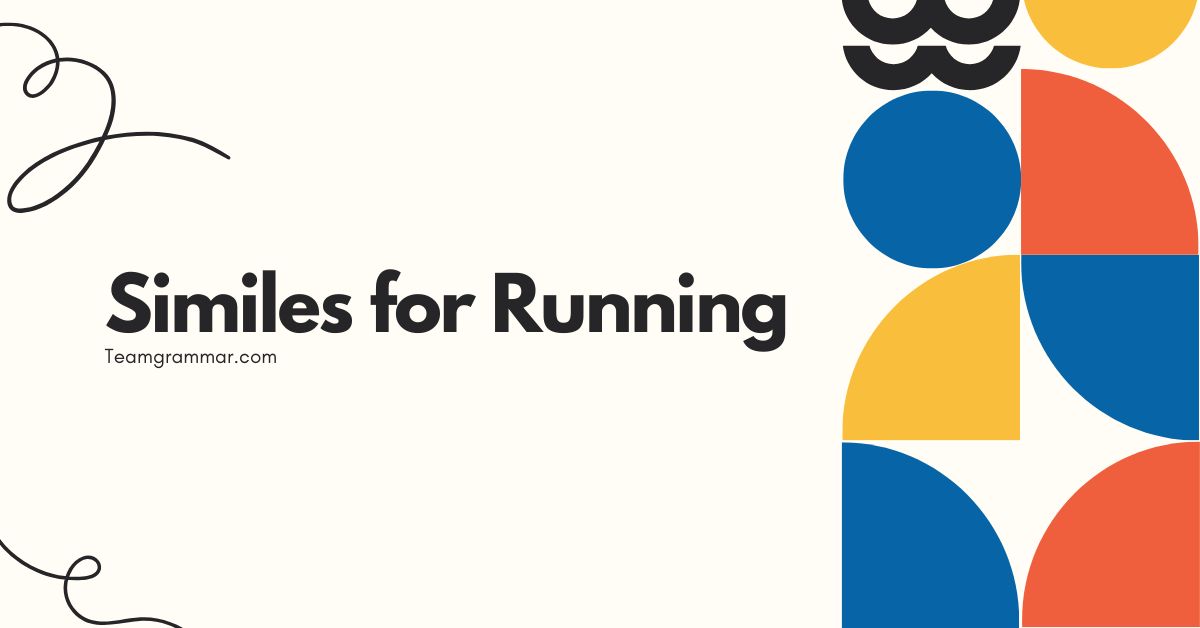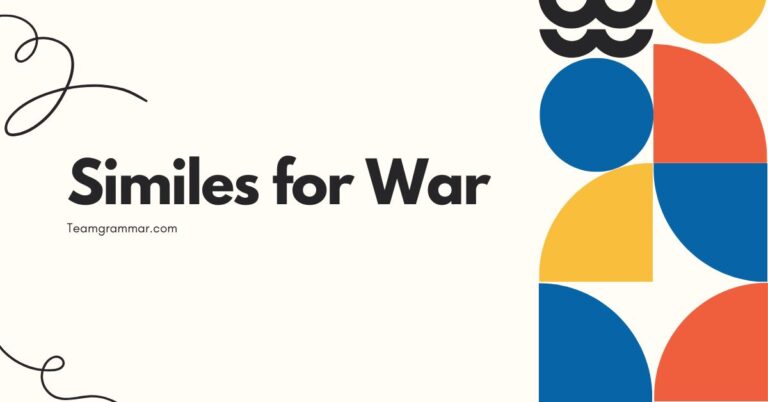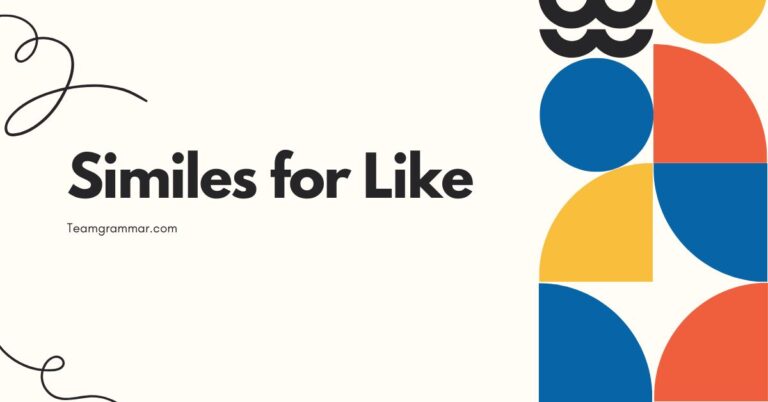27 Similes for Running: Enhancing Descriptions with Figurative Language
Understanding and using similes is crucial for enriching your descriptive writing, especially when depicting dynamic activities like running. Similes add vividness and depth, allowing writers to create memorable images in the reader’s mind.
This article explores the art of crafting similes specifically related to running, covering their structure, types, and usage. Whether you’re a student, a writer, or simply an English enthusiast, this guide will equip you with the knowledge and skills to effectively employ similes and elevate your writing.
By mastering the techniques presented here, you can transform ordinary descriptions of running into captivating narratives. We’ll delve into various examples, analyze common mistakes, and provide practical exercises to solidify your understanding.
This comprehensive guide will help you inject creativity and precision into your writing, making it more engaging and impactful.
Table of Contents
- Definition of Simile
- Structural Breakdown of Similes
- Types of Similes
- Examples of Similes for Running
- Usage Rules for Similes
- Common Mistakes with Similes
- Practice Exercises
- Advanced Topics in Similes
- Frequently Asked Questions
- Conclusion
Definition of Simile
A simile is a figure of speech that directly compares two different things using the words “like” or “as.” The primary function of a simile is to enhance description by highlighting the similarities between two seemingly unrelated entities. Similes add color, depth, and emotional resonance to writing, making it more evocative and engaging for the reader.
Unlike metaphors, which imply a direct equivalence, similes explicitly state a comparison.
Similes are widely used in literature, poetry, and everyday conversation to make ideas more understandable and relatable. They help the audience visualize or comprehend abstract concepts by associating them with familiar objects or experiences.
In the context of describing running, similes can capture the speed, effort, and sensations involved, creating a more immersive experience for the reader or listener.
Classification of Similes
Similes can be classified based on the type of comparison they make. Some common classifications include:
- Descriptive Similes: These similes focus on physical attributes or characteristics.
- Emotional Similes: These similes relate to feelings or emotional states.
- Action-Oriented Similes: These similes describe actions or movements.
Function of Similes
The primary function of a simile is to create a vivid comparison that enhances understanding or appreciation. Similes make writing more engaging by adding layers of meaning and imagery.
They can also simplify complex ideas by relating them to more familiar concepts. In the context of running, similes can effectively convey the nuances of the sport, such as the feeling of exhaustion or the exhilaration of speed.
Contexts of Simile Usage
Similes are appropriate in a wide range of contexts, including:
- Creative Writing: Novels, short stories, and poetry often use similes to enrich the narrative and evoke emotion.
- Descriptive Essays: Similes can help create vivid imagery and convey specific details.
- Conversational Speech: Similes are frequently used in everyday language to make comparisons and express ideas.
- Journalism: Similes can be used to add color and detail to news reports and feature articles.
Structural Breakdown of Similes
A simile typically consists of three key components: the subject being described, the linking word (“like” or “as”), and the object or concept to which the subject is being compared. Understanding these components is essential for constructing effective and meaningful similes.
The structure of a simile is relatively straightforward but requires careful consideration to ensure that the comparison is both logical and evocative. The choice of linking word (“like” or “as”) can subtly influence the tone and impact of the simile.
The object of comparison should be chosen to highlight a specific quality or characteristic of the subject.
Subject of the Simile
The subject is the entity being described. It could be a person, place, thing, or concept.
In the context of running, the subject might be the runner, their pace, or their feeling during the run. For example, in the simile “He ran like the wind,” the subject is “He” (the runner).
Linking Word (“Like” or “As”)
The linking word is the connector that establishes the comparison. The two most common linking words are “like” and “as.” While they are often interchangeable, “as” can sometimes suggest a stronger or more direct comparison than “like.”
Object of Comparison
The object of comparison is the entity to which the subject is being compared. This should be something familiar or easily understood, allowing the reader to grasp the intended similarity.
In the example “He ran like the wind,” the object of comparison is “the wind,” which conveys speed and swiftness.
Patterns in Simile Construction
There are several common patterns in simile construction:
- Subject + Linking Word + Object of Comparison: e.g., “She ran like a deer.”
- Subject + Verb + Linking Word + Object of Comparison: e.g., “He moved as quickly as a cheetah.”
- Subject + Linking Word + Adjective + Object of Comparison: e.g., “The road was like a long, winding snake.”
Types of Similes
Similes can be categorized based on the quality or characteristic they emphasize. Understanding these categories can help you choose the most effective simile for your descriptive needs.
Descriptive Similes
Descriptive similes focus on physical attributes or appearances. They paint a vivid picture of the subject by comparing its physical characteristics to something else.
Example: “The runner’s form was as fluid as water.”
Emotional Similes
Emotional similes convey feelings or emotional states. They help the reader understand the emotional impact of the running experience.
Example: “His exhaustion felt like a heavy weight on his shoulders.”
Action-Oriented Similes
Action-oriented similes describe actions or movements. They capture the dynamics of running, such as speed, agility, or endurance.
Example: “She sprinted like a rocket taking off.”
Exaggerated Similes
Exaggerated similes, sometimes known as hyperbole, use comparison to amplify a certain aspect or trait. While they shouldn’t be taken literally, these similes help to emphasize a point in a humorous or dramatic way.
In the context of running, these can be used to great effect to depict extreme exhaustion or unparalleled speed.
Example: “He was running as if his life depended on it.”
Understated Similes
In contrast to exaggerated similes, understated similes downplay a particular characteristic or action. These can be used to add a touch of irony or humor to the narrative.
In running, they can describe a particularly easy or effortless run.
Example: “She ran as if she was just taking a leisurely stroll.”
Examples of Similes for Running
The following tables provide a wide range of examples of similes related to running, categorized by the aspect of running they describe. Each example aims to illustrate how similes can be used to create vivid and engaging descriptions.
The examples are designed to inspire and provide a foundation for creating your own unique similes. Experiment with different comparisons and word choices to find the most effective way to convey your intended meaning.
Similes Describing Speed
The table below showcases similes used to describe the speed of a runner. These similes often involve comparisons to fast animals, vehicles, or natural phenomena.
| Simile | Explanation |
|---|---|
| He ran like the wind. | Implies extreme speed and swiftness. |
| She sprinted as fast as a cheetah. | Compares the runner’s speed to one of the fastest animals. |
| They moved like rockets. | Suggests rapid acceleration and high velocity. |
| He was as quick as lightning. | Highlights the sudden and instantaneous nature of the runner’s speed. |
| She took off like a shot. | Expresses an immediate and forceful burst of speed. |
| He dashed as swiftly as an arrow. | Compares the runner’s speed to the direct and rapid trajectory of an arrow. |
| She accelerated like a race car. | Implies a gradual yet powerful increase in speed. |
| He ran as if propelled by a jet engine. | Indicates an almost superhuman level of speed and power. |
| She flew like a bird in flight. | Conveys a sense of effortless speed and grace. |
| He zoomed past as quickly as a bullet. | Emphasizes the runner’s speed and the brevity of their presence. |
| She ran as fast as greased lightning. | An intensified version of “quick as lightning,” emphasizing incredible speed. |
| He sped off like a bat out of hell. | Indicates a very rapid and somewhat frantic departure. |
| She darted like a hummingbird. | Suggests quick, erratic movements and bursts of speed. |
| He rushed forward like a runaway train. | Implies unstoppable speed and momentum. |
| She bolted like a spooked horse. | Conveys sudden and startled acceleration. |
| He charged ahead like a bull. | Indicates aggressive and forceful speed. |
| She raced like a meteor across the sky. | Emphasizes brilliant and fleeting speed. |
| He tore down the track like a hurricane. | Suggests destructive and overwhelming speed. |
| She zipped by like a laser beam. | Implies precise and focused speed. |
| He galloped like a wild stallion. | Conveys untamed and powerful speed. |
| She ran across the field as fast as her legs could carry her. | Expresses the runner’s maximum effort to achieve high speed. |
| He was off like a flash. | Highlights the instantaneous start and extreme speed. |
| She ran like she had wings on her feet. | Suggests effortless and swift movement. |
Similes Describing Effort and Exertion
This table presents similes that capture the feeling of effort and exertion experienced during running. These similes often involve comparisons to heavy objects, difficult tasks, or physical struggles.
| Simile | Explanation |
|---|---|
| His breath came as heavy as lead. | Indicates labored breathing due to exhaustion. |
| Her legs felt like concrete blocks. | Conveys the feeling of heavy, immobile legs. |
| The pain was like a burning fire in his muscles. | Expresses intense muscle pain. |
| She pushed herself as hard as a machine. | Suggests relentless effort and determination. |
| He struggled like a swimmer against the tide. | Implies a difficult and challenging effort. |
| Her body ached like it had been beaten with hammers. | Conveys severe and widespread muscle soreness. |
| He felt as drained as a squeezed lemon. | Indicates complete exhaustion and lack of energy. |
| She ran as if she were carrying the weight of the world on her shoulders. | Suggests a heavy burden and great effort. |
| His heart pounded like a drum. | Expresses a rapid and forceful heartbeat due to exertion. |
| She persevered like a marathon runner nearing the finish line. | Implies unwavering determination despite exhaustion. |
| He was sweating like a pig. | Indicates profuse sweating due to intense effort. |
| She ran as if she was running through molasses. | Conveys a feeling of slow and sticky resistance. |
| His muscles tightened like steel cables. | Suggests extreme tension and strain. |
| She gasped for air like a fish out of water. | Implies a desperate need for oxygen. |
| He pushed through the pain like a warrior. | Indicates resilience and determination in the face of suffering. |
| She felt as though she was running uphill both ways. | Exaggerates the difficulty and challenge of the run. |
| His lungs burned like they were filled with fire. | Expresses intense respiratory discomfort. |
| She ran as if every step was a monumental effort. | Highlights the difficulty and exhaustion of each stride. |
| He dug in like a badger. | Suggests tenacity and determination to overcome obstacles. |
| She fought fatigue like a lioness protecting her cubs. | Implies fierce determination and unwavering commitment. |
| He was working as hard as a beaver building a dam. | Suggests persistent and tireless effort. |
| She felt as though she was carrying a ton of bricks on her back. | Indicates an overwhelming sense of burden and fatigue. |
| He strained like an engine at full throttle. | Conveys maximum effort and power output. |
Similes Describing the Runner’s Form and Style
This table illustrates similes used to describe the runner’s form and style. These similes often involve comparisons to graceful animals, dancers, or flowing movements.
| Simile | Explanation |
|---|---|
| Her stride was as smooth as silk. | Conveys a fluid and effortless running motion. |
| He moved like a gazelle. | Suggests grace, agility, and lightness. |
| She ran with the elegance of a dancer. | Implies poise, control, and artistic flair. |
| His form was as fluid as water. | Highlights the seamless and adaptable nature of the runner’s movements. |
| She floated like a feather. | Expresses a sense of weightlessness and ease. |
| He glided like a swan. | Conveys grace, beauty, and effortless movement. |
| She bounded like a kangaroo. | Suggests powerful leaps and energetic strides. |
| His movements were as precise as clockwork. | Implies accuracy, consistency, and efficiency. |
| She flowed like a river. | Conveys a continuous and natural motion. |
| He weaved through the crowd like a snake. | Suggests agility, flexibility, and stealth. |
| She ran with the precision of a surgeon. | Implies meticulous attention to detail and controlled movements. |
| He lumbered like a bear. | Suggests a heavy, powerful, but less graceful movement. |
| She skipped like a happy child. | Conveys lightness, joy, and carefree movement. |
| He marched like a soldier. | Implies discipline, strength, and unwavering determination. |
| She pranced like a show pony. | Suggests elegance, flamboyance, and showmanship. |
| He moved like a well-oiled machine. | Conveys efficiency, smoothness, and reliability. |
| She drifted like a leaf on the wind. | Suggests a light, uncontrolled, and effortless movement. |
| He strode confidently like a seasoned athlete. | Implies experience, poise, and self-assurance. |
| She leaped like a frog. | Suggests a sudden, energetic jump. |
| He hopped like a rabbit. | Conveys a light, quick, and repetitive movement. |
| She shuffled like an old man. | Suggests a slow, weary, and unsteady movement. |
| He swaggered like a cowboy. | Implies confidence, arrogance, and a distinctive gait. |
| She tiptoed like a ballerina. | Conveys grace, delicacy, and quiet movement. |
Similes Describing the Running Environment
Many similes can be used to describe the environment in which the running takes place. Here are some examples that help to paint a vivid picture of the surroundings.
| Simile | Explanation |
|---|---|
| The path stretched ahead like a ribbon. | Suggests a long, narrow, and winding trail. |
| The air was as thick as soup. | Conveys a humid, heavy, and oppressive atmosphere. |
| The forest was as dark as night. | Implies a dense, shadowy, and impenetrable woodland. |
| The road was like a furnace. | Suggests intense heat and scorching conditions. |
| The rain fell like needles. | Conveys a sharp, stinging, and unpleasant sensation. |
| The wind howled like a wolf. | Implies a fierce, mournful, and intimidating sound. |
| The hills rose like giants. | Suggests towering, imposing, and formidable obstacles. |
| The sun beat down like a hammer. | Conveys intense, relentless, and punishing heat. |
| The snow sparkled like diamonds. | Implies brilliance, beauty, and dazzling light. |
| The trail was as rough as sandpaper. | Suggests a coarse, abrasive, and uncomfortable surface. |
| The mud sucked at his shoes like quicksand. | Conveys a sticky, clinging, and immobilizing force. |
| The fog hung like a shroud. | Implies a dense, obscuring, and ominous atmosphere. |
| The trees stood like silent sentinels. | Suggests stillness, watchfulness, and a sense of protection. |
| The river flowed like liquid silver. | Conveys beauty, elegance, and shimmering light. |
| The mountains loomed like sleeping dragons. | Implies grandeur, mystery, and latent power. |
| The sky was as blue as sapphire. | Suggests a deep, rich, and vibrant color. |
| The leaves crunched like potato chips. | Conveys a crisp, brittle, and satisfying sound. |
| The air smelled as fresh as a daisy. | Suggests purity, cleanliness, and invigorating scent. |
| The path twisted like a rollercoaster. | Implies sudden turns, steep inclines, and exhilarating challenges. |
| The shadows stretched like long fingers. | Conveys a sense of mystery, unease, and looming presence. |
Usage Rules for Similes
Using similes effectively requires adherence to certain rules to ensure clarity and impact. These rules cover the choice of comparisons, the use of linking words, and the overall context of the simile.
Choose Relevant Comparisons
The object of comparison should be relevant to the subject and highlight a specific quality or characteristic. Avoid comparisons that are illogical or obscure.
Use “Like” or “As” Appropriately
While “like” and “as” are often interchangeable, consider the subtle nuances of each word and choose the one that best conveys the intended comparison.
Avoid Cliches
Cliches are overused similes that have lost their impact. Strive for originality and creativity in your comparisons.
Maintain Consistency
Ensure that the simile is consistent with the tone and style of your writing. Avoid jarring or incongruous comparisons.
Ensure Clarity
The simile should be easily understood by the reader. Avoid obscure or overly complex comparisons that may confuse the audience.
Exceptions and Special Cases
While the general rules apply, there are exceptions and special cases where similes can be used more creatively or unconventionally. For example, in poetry or experimental writing, similes may be used to create surreal or abstract comparisons.
Common Mistakes with Similes
Several common mistakes can undermine the effectiveness of similes. These mistakes include using cliches, creating illogical comparisons, and misusing linking words.
Using Cliches
Cliches are overused similes that have lost their impact. Examples include “as fast as lightning” or “like a fish out of water.”
Incorrect: He ran as fast as lightning.
Correct: He sprinted like a rocket taking off.
Creating Illogical Comparisons
The object of comparison should be logically related to the subject. Avoid comparisons that are nonsensical or confusing.
Incorrect: She ran like a refrigerator.
Correct: She ran like a gazelle.
Misusing Linking Words
Ensure that “like” or “as” is used correctly to establish the comparison. Avoid using other words or phrases that may obscure the meaning.
Incorrect: He ran similar to a cheetah.
Correct: He ran like a cheetah.
Overusing Similes
While similes can enrich writing, overuse can make the text feel forced or artificial. Use them sparingly to maximize their impact.
Poor: He ran like the wind, his breath coming as heavy as lead, his legs feeling like concrete blocks.
Better: He ran like the wind, his breath coming as heavy as lead.
Practice Exercises
The following exercises will help you practice creating and identifying effective similes for running. Each exercise focuses on a different aspect of simile usage.
Exercise 1: Identifying Similes
Identify the similes in the following sentences.
| Question | Answer |
|---|---|
| 1. She ran as fast as a cheetah. | as fast as a cheetah |
| 2. His legs felt like concrete blocks. | like concrete blocks |
| 3. The pain was intense. | (No simile in this sentence) |
| 4. He moved like a gazelle. | like a gazelle |
| 5. She pushed herself as hard as a machine. | as hard as a machine |
| 6. The wind howled. | (No simile in this sentence) |
| 7. He struggled like a swimmer against the tide. | like a swimmer against the tide |
| 8. She ran with elegance. | (No simile in this sentence) |
| 9. His heart pounded like a drum. | like a drum |
| 10. The path stretched ahead like a ribbon. | like a ribbon |
Exercise 2: Completing Similes
Complete the following similes with an appropriate object of comparison.
| Question | Answer |
|---|---|
| 1. He ran like a __________. | cheetah |
| 2. Her breath came as heavy as __________. | lead |
| 3. She moved as smoothly as __________. | silk |
| 4. His legs felt like __________. | concrete blocks |
| 5. He pushed himself as hard as a __________. | machine |
| 6. She sprinted like a __________. | rocket |
| 7. He was as quick as __________. | lightning |
| 8. She took off like a __________. | shot |
| 9. He dashed as swiftly as an __________. | arrow |
| 10. She accelerated like a __________. | race car |
Exercise 3: Creating Similes
Create your own similes to describe the following aspects of running.
| Aspect of Running | Example Simile |
|---|---|
| 1. The feeling of exhaustion | His exhaustion felt like a heavy weight on his shoulders. |
| 2. The runner’s speed | She ran as fast as a cheetah. |
| 3. The runner’s form | His stride was as smooth as silk. |
| 4. The sound of footsteps | Her footsteps echoed like drumbeats. |
| 5. The runner’s determination | He persevered like a marathon runner nearing the finish line. |
| 6. The feeling of freedom | She felt as free as a bird in flight. |
| 7. The runner’s breathing | His breath came as ragged as torn cloth. |
| 8. The runner’s pain | Her muscles ached like they had been beaten with hammers. |
| 9. The runner’s focus | His eyes were as focused as a hawk’s gaze. |
| 10. The runner’s energy | She was as energetic as a bouncing ball. |
Advanced Topics in Similes
For advanced learners, understanding more nuanced aspects of similes can further enhance their writing. These topics include extended similes, metaphorical similes, and the use of similes in different literary styles.
Extended Similes
An extended simile is a simile that is developed over several lines or sentences, providing a more detailed and elaborate comparison. This technique can create a more vivid and immersive image for the reader.
Example: “Running a marathon is like climbing a mountain; each step is a challenge, the summit seems impossibly far, and the journey tests your physical and mental limits.”
Metaphorical Similes
Metaphorical similes combine elements of both similes and metaphors, creating a layered comparison that adds depth and complexity. These similes often involve abstract or symbolic comparisons.
Example: “His determination was like a shield, protecting him from the arrows of doubt and fatigue.”
Similes in Different Literary Styles
The use of similes can vary depending on the literary style. In formal writing, similes may be used sparingly and with precision.
In creative writing, similes may be used more liberally to create vivid imagery and evoke emotion.
Frequently Asked Questions
- What is the difference between a simile and a metaphor?
A simile uses “like” or “as” to make a direct comparison, while a metaphor implies a direct equivalence without using these words. For example, “He is like a lion” (simile) vs. “He is a lion” (metaphor).
- Can a simile be a cliche?
Yes, a simile can be a cliche if it is overused and lacks originality. It’s best to avoid common comparisons and strive for fresh, creative expressions.
- How can I make my similes more effective?
Choose relevant and vivid comparisons, avoid cliches, and ensure that the simile is consistent with the tone and style of your writing. The more specific and unique the comparison, the more impactful it will be.
- Is it okay to use similes in formal writing?
Yes, similes can be used in formal writing, but they should be used sparingly and with precision. Ensure that the simile is appropriate for the context and enhances the clarity of your writing.
- What are some alternatives to using similes?
Alternatives to similes include metaphors, analogies, personification, and descriptive language. These techniques can also be used to create vivid imagery and enhance your writing.
- How do I avoid making illogical comparisons in my similes?
Ensure that the object of comparison is logically related to the subject. Ask yourself if the comparison makes sense and effectively highlights a specific quality or characteristic.
- Can similes be used in spoken language?
Yes, similes are frequently used in spoken language to make comparisons and express ideas. They can add color and emphasis to your speech.
- What is the role of similes in poetry?
Similes play a crucial role in poetry by creating vivid imagery, evoking emotion, and adding depth to the poem’s meaning. They help the reader visualize and connect with the poet’s message.
- How can an extended simile improve my writing?
An extended simile allows you to develop a more detailed and elaborate comparison, creating a more vivid and immersive image for the reader. This can enhance the impact and memorability of your writing.
- Are similes only used to describe physical characteristics?
No, similes can be used to describe a wide range of qualities, including emotions, actions, and abstract concepts. They are versatile tools for enhancing description in various contexts.
Conclusion
Mastering the use of similes is a valuable skill for any writer or English language learner. By understanding the structure, types, and usage rules of similes, you can effectively enhance your descriptive writing and create more engaging and impactful narratives.
Similes
add depth, color, and emotional resonance to your work, making it more memorable for your audience.
Through the examples and exercises provided in this article, you should now have a solid foundation for crafting your own similes for running and other topics. Remember to choose relevant comparisons, avoid cliches, and maintain consistency in your writing.
With practice and attention to detail, you can elevate your writing and express your ideas with greater clarity and creativity. Happy writing!







